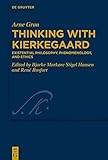Thinking with Kierkegaard : Existential Philosophy, Phenomenology, and Ethics / Arne Grøn; ed. by Bjarke Mørkøre Stigel Hansen, René Rosfort.
Material type: TextSeries: Kierkegaard Studies. Monograph Series ; 44Publisher: Berlin ; Boston : De Gruyter, [2022]Copyright date: ©2023Description: 1 online resource (LII, 614 p.)Content type:
TextSeries: Kierkegaard Studies. Monograph Series ; 44Publisher: Berlin ; Boston : De Gruyter, [2022]Copyright date: ©2023Description: 1 online resource (LII, 614 p.)Content type: - 9783110793574
- 9783110794182
- 9783110793895
- online - DeGruyter
- Issued also in print.
| Item type | Current library | Call number | URL | Status | Notes | Barcode | |
|---|---|---|---|---|---|---|---|
 eBook
eBook
|
Biblioteca "Angelicum" Pont. Univ. S.Tommaso d'Aquino Nuvola online | online - DeGruyter (Browse shelf(Opens below)) | Online access | Not for loan (Accesso limitato) | Accesso per gli utenti autorizzati / Access for authorized users | (dgr)9783110793895 |
Browsing Biblioteca "Angelicum" Pont. Univ. S.Tommaso d'Aquino shelves, Shelving location: Nuvola online Close shelf browser (Hides shelf browser)

|

|

|

|

|

|

|
||
| online - DeGruyter La traduzione latina del ‹Nicocles› isocrateo di Guarino Veronese : Introduzione, edizione critica e commento / | online - DeGruyter Doppelte Artikulation : Schriften zur neueren Kunst II / | online - DeGruyter Dual-Use-Risiko im Strafrecht / | online - DeGruyter Thinking with Kierkegaard : Existential Philosophy, Phenomenology, and Ethics / | online - DeGruyter French theories on text and discourse / | online - DeGruyter Intervisuality : New Approaches to Greek Literature / | online - DeGruyter In the Footsteps of Dante : Crossroads of European Humanism / |
Frontmatter -- Table of Contents -- Tabula Gratulatoria -- Thinking with Kierkegaard: Introduction and Chapter Overview -- Arne Grøn’s Bibliography -- Editorial Comments -- Acknowledgments and Sources -- Abbreviations -- Part One: Existential Philosophy -- Chapter 1 The Concept of Existence -- Chapter 2 Existence and Dialectics -- Chapter 3 The Human Synthesis -- Chapter 4 Self and Identity -- Chapter 5 Spirit and Temporality in The Concept of Anxiety -- Chapter 6 The Embodied Self: Reformulating the Existential Difference in Kierkegaard -- Chapter 7 Temporality in Kierkegaard’s Edifying Discourses -- Chapter 8 Mediated Immediacy? -- Chapter 9 Ein Leben zu führen: Kierkegaard und der Begriff des Lebens -- Chapter 10 Zweideutigkeiten der Angst -- Chapter 11 Subjektivität und Un-Wahrheit -- Chapter 12 Religion und Subjektivität – in existenzieller und pragmatischer Perspektive -- Chapter 13 Paradox des Denkens – paradoxes Denken -- Part Two: Phenomenology -- Chapter 14 Self-Givenness and Self-Understanding -- Chapter 15 Phenomenology of Despair – Phenomenology of Spirit -- Chapter 16 Time, Courage, Selfhood: Reflections on Kierkegaard’s Discourse “To Preserve One’s Soul in Patience” -- Chapter 17 The Relation Between Part One and Part Two of The Sickness Unto Death -- Chapter 18 Transcendence of Thought: The Project of Philosophical Fragments -- Chapter 19 Der Begriff Verzweiflung -- Chapter 20 Kierkegaards Phänomenologie? -- Chapter 21 Phänomenologie der Subjektivität. Überlegungen zu Kierkegaards Abhandlung über die menschliche Freiheit -- Chapter 22 Zeit und Transzendenz -- Chapter 23 Das Transzendenzproblem bei Kierkegaard und beim späten Schelling -- Part Three: Ethics -- Chapter 24 Ethics of Vision -- Chapter 25 Ethics of In-Visibility -- Chapter 26 The Dialectic of Recognition in Works of Love -- Chapter 27 Dialectics of Recognition: Selfhood and Alterity -- Chapter 28 Repetition and the Concept of Repetition -- Chapter 29 The Ethical Demand: Kierkegaard, Løgstrup, and Levinas -- Chapter 30 Subjectivity, Interiority, and Exteriority: Kierkegaard and Levinas -- Chapter 31 Time and History -- Chapter 32 Future of Hope – History of Hope -- Chapter 33 Kierkegaards „zweite“ Ethik -- Chapter 34 Gegenseitigkeit in Der Liebe Tun? -- Chapter 35 Un-sichtbar. Den Nächsten sehen -- Index
restricted access online access with authorization star
http://purl.org/coar/access_right/c_16ec
Arne Grøn’s reading of Søren Kierkegaard’s authorship revolves around existential challenges of human identity. The 35 essays that constitute this book are written over three decades and are characterized by combining careful attention to the augmentative detail of Kierkegaard’s text with a constant focus on issues in contemporary philosophy. Contrary to many approaches to Kierkegaard’s authorship, Grøn does not read Kierkegaard in opposition to Hegel. The work of the Danish thinker is read as a critical development of Hegelian phenomenology with particular attention to existential aspects of human experience. Anxiety and despair are the primary existential phenomena that Kierkegaard examines throughout his authorship, and Grøn uses these negative phenomena to argue for the basically ethical aim of Kierkegaard’s work. In Grøn’s reading, Kierkegaard conceives human selfhood not merely as relational, but also a process of becoming the self that one is through the otherness of self-experience, that is, the body, the world, other people, and God. This book should be of interest to philosophers, theologians, literary studies scholars, and anyone with an interest not only in Kierkegaard, but also in human identity.
Issued also in print.
Mode of access: Internet via World Wide Web.
In English.
Description based on online resource; title from PDF title page (publisher's Web site, viewed 29. Mai 2023)


